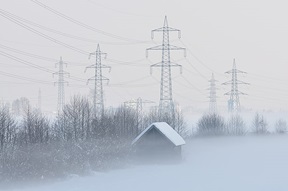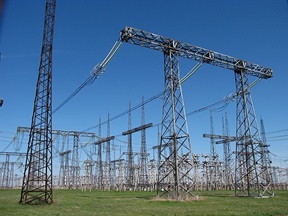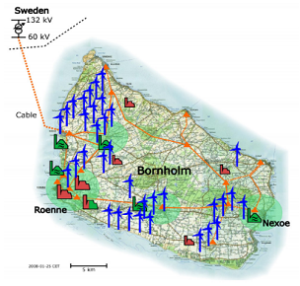The electricity grid is being overburdened fast. Local production, mainly through solar and wind energy, produces an uneven distribution of demand and supply across the grid. Leading to the need to transport major amounts of electricity across large distances. In order to prevent overburdening the grid, we should embrace a new philosophy: local grid optimization.

Continue along the existing road
The fact that we should look differently at the electric grid hasn’t yet surfaced to the powerful International Energy Agency (IEA). They are of the opinion that we should solve problems the way we always did: by constructing new infrastructure. Which would total 80 million kilometres of energy infrastructure before 2040, in order to satisfy climate requirements and ensure energy stability. This would require six lines of action:
- Investments in electricity infrastructure reinforcement
- Better planning
- Digitization for efficiency improvement
- Better qualified staff
- Planning ahead additional investments
- Materials standardization
There is an urgent need to embark on such a policy, says IEA. Strengthening the grid is time consuming, whereas the construction of new solar panels and wind turbines can be done much faster – let alone building new charging-points for electric cars. There is an ever-growing list of projects that cannot be executed because of a lack of capacity on the grid. The IEA estimates this amount at 1.500 GW in total; five times as much as all additions of solar and wind energy together, last year. It is quite unclear how to solve this problem.
New avenues
But fortunately, there are alternatives to the classic solution of grid reinforcement. Thomas Danes and Willem van de Zande of WSP consultants have developed an alternative: local grid optimization. Fortunately so, for there is a pressing need for it. There are too many major electricity consumers waiting to be connected to the grid already. If anything, this will slow down the energy transition.
Griod reinforcement is necessary but not sufficient, they expect. In the Netherlands for instance, grid reinforcement is slowed down by a lack of adequately trained staff. Moreover, it isn’t economically wise to reinforce the entire grid. In other words: we should develop other solutions as well.

Storage
Van de Zande and Danes look upon energy storage as an important avenue – both in the short and in the long term. Battery systems are part of the solution, but their capacity is limited. Danes: ‘Battery technology allows us to store energy for a short amount of time. But we should be able to store major amounts of energy for weeks and even months. For such a time frame, battery systems are not the adequate solution.’ At the moment, hydrogen storage is one of the technologies in development by their company. But that will not be sufficient either.
Major electricity consumers already have a contract that implies demand reduction at peak moments – but this system will have to be enlarged. That in itself will require a different approach. And a more fundamental approach will also be required: local grid optimization. The creation of ‘energy hubs’. These ‘hubs’ level out local fluctuations in energy demand and supply; in doing so, they create a balance on a small, regional portion of the electricity grid. A combination of techniques will facilitate this; from smart algorithms to local electricity production, and to energy storage in different forms. In doing so, says Danes, we will divide up the national problem of grid congestion to smaller, manageable bits. This will create semi-autonomous islands that can be optimized in themselves (local grid optimization); resulting in much less demand on the high-voltage grid.
Oversight and management
Danes and Van de Zande hold that there is not enough oversight and management in these processes. The grid companies have many tasks, now to the detriment of grid optimization. But governments can allow more instruments to the grid companies in managing the grid. Even though a present shortage of qualified personnel might hinder them in the execution of these tasks.
Grid companies can only fulfil this task if they take a different view on their tasks. It should be clear that a proper grid connection isn’t a matter of course anymore. We should apply all solutions all at once; the only opportunity to prepare the grid for its future tasks.
Local grid optimization
One of the companies that have developed software to this end is TIBO Energy in Eindhoven. Their software will allow companies and business parks to calculate themselves how many solar panels, heat pumps, charging points and batteries will be required in order to change over to renewable electricity, while preventing grid congestion. And having done that, the software will also be able to manage such a smart energy system.
TBO Energy’s software can perform calculations on complicated layouts. For instance, where there are not just a solar park and a battery in the system, but also heat pumps and a charging point for electric vehicles. Their system is being applied among others at the Eindhoven Technical University campus, Eindhoven Airport and the experimental Green Energy Park in Belgium. With the extra benefit: the system doesn’t just allow managers to predict the situation – it will also allow them to manage it.
Energy planning
Software for such complicated situations is being developed elsewhere as well. For instance for the industrial area Westpoort in the Dutch province of Groningen. Such software will better control supply and demand of electricity: ‘energy planning’.
In principle, we will have to find a new solution for each situation. Enexis’s Greetje Bronsema points out that we can only do this if companies cooperate. Research shows that such a local grid optimization may be advantageous to many. It may even be advantageous not to use the entire yield of a wind park, preventing overburdening the electric grid. Grid company Enexis concluded a contract to that extent with a wind park exploited by Eneco. ‘We are heading towards an energy system in which such flexible contracts will become ever more important,’ says Enexis’s Karin Matthijssen. ‘At the same time, this is a new concept – not just for us, but for our clients as well…. Enexis is continuously on the lookout for companies that can deliver flexible power, following Eneco’s good example.’

The power of the small scale
All this testifies to the need for local grid optimization of the electricity system. A movement contrary to the present philosophy, according to which the grid, by its sheer size, would even out all changes in production and demand. Small grids like the one on the Danish island of Bornholm lead the way; using local grid optimization. In essence, solar and wind energy are small-scale in nature. In being optimized, the local approach should therefore be leading. Partly, the further ascent of solar and wind energy will depend on acknowledging this small-scale nature in the future design of the energy system.
Interesting? Then also read:
Renewable energy system costs – the untold story
Scale issues in the energy transition
Energy storage will accelerate the transition
